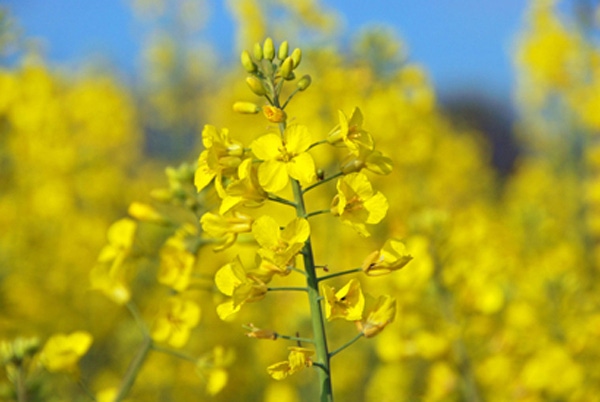October 21, 2010

Winter canola production in the southern Great Plains has come a long way in just six years.
From developing new varieties and production methods to finding a reliable, lucrative market, much has been accomplished in a short time.
With the 2010/11 crop planting nearly completed, reliable estimates say more than 100,000 acres, maybe as much as 115,000 acres, have been put into the ground in Kansas, Oklahoma and North Texas.
Last spring, following a favorable winter growing period, winter canola farmers harvested from 1,500 to 2,000 pounds of canola per acre.
These yields, with $7.80 plus per bushel, sparked a lot of interest among prospective growers attending summer production meetings throughout the area.
Growers with winter canola recently planted in their fields have a lot going for them this coming crop year as well.
Information disseminated by Land Grant universities, seed companies and marketing entities continue to provide pertinent production information. This evolution of information is particularly important to growers planting their first canola crop this fall.
New money crop
Kansas State and Oklahoma State University agronomists, seeking new ways to reduce problem weeds growing in continuously cropped wheat, decided nearly six years ago to emphasize research on a money crop with different characteristics that could be grown in rotation with winter wheat.
Canola, a spring oilseed crop grown in Canada and in the northern U.S., can be farmed with the same equipment as wheat, but it is a completely different crop with distinct agronomic characteristics requiring additional production skills.
Both spring and winter types produce a seed with a high oil content. When processed, the oil is a source of healthy, low fat cooking oil and for biofuels.
Crop breeders created new varieties designed to grow in cool seasons that could be planted in fields where winter wheat had been planted. Canola interrupts the growth cycle of such undesirable weeds as cheatgrass, wild oats and rye. When winter wheat is harvested, the wheat seed is infested with seeds from these weeds. Presence of these weed seeds sharply reduces the price paid wheat farmers.
New Roundup Ready winter canola varieties help farmers control weeds and are doing a good job growing under dryland conditions where soil moisture is always an important factor in making a crop. Canola has a large taproot that allows it to find scarce moisture in Plains soils.
The last important development for a viable canola industry was creating a reliable, competitive regional market close to where the crop is grown. Producers Cooperative Oil Mill (PCOM), in Oklahoma City, provided canola growers a place to market their crop.
Working with area-wide grain terminals where farmers can take canola seed, PCOM not only buys canola seed for processing but also offers farmers production contracts. A farmer-owned, multi-state cooperative with more than 61 years of service to farmers producing cottonseed, PCOM offers opportunities for another important crop option. Prices paid for canola seed by PCOM further enhance it as an important commodity farmers can utilize as a reliable money crop.
More management
New canola growers are told by production experts that planting and growing the crop requires more attention and hands-on skills than typical winter wheat production.
Proper seedbed preparation, calibrating seeding drills for proper planting depth and row spacing, selecting different fertilizer ratios and application timing, controlling pests skills and selecting the best way to harvest canola under various weather conditions are all important skills demanded of growers willing to add winter canola to their commodity mix.
New winter canola growers have a wide range of informational sources and knowledgeable people to help them put a bumper crop in the bin.
Agricultural Extension personnel working for Kansas State University, Oklahoma State University and Texas A&M University cooperate to the benefit of farmers in each state.
Contacts
As a service to winter canola growers in Kansas, Oklahoma and North Texas, the following is a list of people and places to contact for the latest information on canola production:
Dr. Tom Peeper, OSU, Stillwater, Ok., 405-744-6420, [email protected];
Josh Bushong, OSU, Enid, Ok., 580-237-7677, cell 405-361-6941, [email protected], Twitter, www.twitter.com/Tallokie_67;
Mark Boyles, OSU, Stillwater, Ok., 405-880-0539, [email protected];
Ross Haxton, OSU, El Reno, Ok., 405-262-0155, [email protected];
Roger Gribble, OSU Ext. area agent, Enid, Ok., 580-237-7677, [email protected];
Heath Sanders, PCOM, 405-232-7555, cell 580-678-2754, [email protected];
Gene Neuens, PCOM, 405-232-7555, cell 405-760-4205; [email protected];
Brandon Winters, PCOM marketing representative, 405-232-7555; [email protected].
Production information
What could be called the bible of winter canola production in the Southern Great Plains is the Winter Canola Handbook, edited and produced each year by KSU, OSU and the University of Nebraska. The handbook is updated each year and made available at the research report of the Oklahoma-Kansas Winter Canola conference held in July at the Garfield County Fairgrounds in Enid. Copies of the handbook, an invaluable compendium of winter canola production, harvesting and marketing, can be obtained by contacting the OSU County Extension director in each county, any of the people listed in this article and by contacting Producers Cooperative Oil Mill at 405-232-7555, or producerscoop.net.
Other information can be obtained on the web at the Okanola link page at okstate.edu and/or plainsoilseedproducts.com.
Oklahoma winter canola producers are represented by the Oklahoma Oilseed Commission, which oversees a checkoff fund to support development of new winter canola production methods.
Members of the commission are Kelly Chain, Alan Mindemann, Lee Leeper, Brent Rendel and Brent Thompson.
You May Also Like




